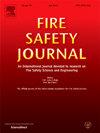Smoke control using natural ventilation shafts in a tunnel during construction under the effect of geothermal condition
IF 3.4
3区 工程技术
Q2 ENGINEERING, CIVIL
引用次数: 0
Abstract
An increasing number of tunnels experiencing geothermal hazards are being constructed in the western regions of China. During construction, tunnels have a confined structure, and shafts are typically installed to facilitate transportation and enhance ventilation. Once a fire occurs in these tunnels, their management faces the added challenges posed by geothermal hazards. To investigate the performance of natural smoke exhaust from the construction shaft under the influence of geothermal conditions, a series of fire tests in a 1/20 scale model tunnel have been conducted. Results indicate that the hot air and initial temperature field generated by geothermal conditions reduce heat loss during smoke movement. The smoke temperature and smoke layer thickness behind the shaft decrease significantly with increasing shaft height, while both increase with an increase in geothermal temperature. The smoke movement patterns within the shaft are affected by the geothermal temperature. Specifically, the boundary layer separation is intensified, while the plug-holing is mitigated as the geothermal temperature increases. The mass flow rate exhausted from the shaft increases with both increasing shaft height and geothermal temperature, and a dimensionless model is proposed to calculate the mass flow rate of mixed smoke. The heat exhaust efficiency of the shaft initially increases and then decreases with shaft height due to the plug-holing phenomenon, while it reduces with increasing geothermal temperature for a given shaft height.
地热条件下隧道施工中自然通风井的防烟效果研究
中国西部地区正在建设越来越多的地热灾害隧道。在施工过程中,隧道具有密闭结构,通常安装竖井以方便运输和增强通风。一旦这些隧道发生火灾,它们的管理将面临地热危害带来的额外挑战。为了研究地热条件下施工竖井自然排烟的性能,在1/20比例模型隧道中进行了一系列火灾试验。结果表明,地热条件下产生的热空气和初始温度场减少了烟气运动过程中的热损失。井后烟温和烟层厚度随井高的增加而显著降低,随地热温度的升高而增加。地温对竖井内烟气的运动规律有影响。具体来说,随着地热温度的升高,边界层分离加剧,钻塞现象减弱。竖井排烟质量流量随竖井高度和地热温度的增加而增加,提出了一种计算混合烟质量流量的无因次模型。竖井排热效率由于堵孔现象的存在,随着竖井高度的增加,排热效率先增大后减小,在一定竖井高度下,随着地热温度的升高,排热效率减小。
本文章由计算机程序翻译,如有差异,请以英文原文为准。
求助全文
约1分钟内获得全文
求助全文
来源期刊

Fire Safety Journal
工程技术-材料科学:综合
CiteScore
5.70
自引率
9.70%
发文量
153
审稿时长
60 days
期刊介绍:
Fire Safety Journal is the leading publication dealing with all aspects of fire safety engineering. Its scope is purposefully wide, as it is deemed important to encourage papers from all sources within this multidisciplinary subject, thus providing a forum for its further development as a distinct engineering discipline. This is an essential step towards gaining a status equal to that enjoyed by the other engineering disciplines.
 求助内容:
求助内容: 应助结果提醒方式:
应助结果提醒方式:


